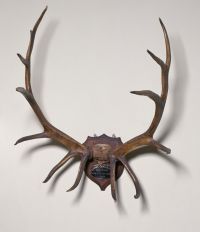Elk Antlers
Artist/Maker: acquired by Meriwether Lewis (1774-1809) and William Clark (1770-1838)
Created: c. 1804-1805
Origin/Purchase: North Dakota
Dimensions: tip to tip: 75.2 (29 5/8 in.)
Location: Entrance Hall
Provenance: Lewis and Clark; by gift to Thomas Jefferson; by gift to the University of Virginia; by loan to the Thomas Jefferson Foundation since 1949
Accession Number: 1949-2
Historical Notes: Of the many animal natural history specimens sent to Jefferson by Lewis and Clark, only one is extant: the elk antlers now in the Entrance Hall at Monticello, listed on Lewis's invoice as "1 large par [sic] of Elk's horns connected by the frontal bone."[1] These antlers probably came from one of the fifty elk the expedition members killed over the winter of 1804-1805 in the Fort Mandan area.[2] After display at the President's House over the winter, the antlers came to Monticello in March 1806, with various other items from Lewis and Clark's 1805 shipment.[3] Descriptions left by visitors in Jefferson's lifetime place the antlers on the walls of the Entrance Hall beside those of a moose and a deer.
Through careful study of Lewis and Clark's notes and drawings, modern scholars have credited the explorers with the identification by Western science of at least twenty-five species of mammals.[4] In his parting instructions to Lewis, Jefferson wrote that "the animals of the country generally, & especially those not known in the US." were worthy of notice.[5] Lewis and Clark explicitly followed Jefferson's instructions. Along with recording in detail their sightings of all types of animals, the exploration party collected skins, horns, entire skeletons, and even live specimens to send back to Jefferson in Washington.
It seems likely that Lewis obtained some instruction from Charles Willson Peale prior to the expedition on the preservation of animal skins, bones, and skeletons, but Lewis's attempt to send back six live animals (four magpies, a "burrowing Squirel of the praries," and a "hen of the Prarie") was an exceptionally bold idea.[6] The animals were part of a shipment sent by Lewis and Clark from Fort Mandan in April 1805. After traveling to St. Louis, New Orleans, and Baltimore, only one magpie and the "burrowing squirel" survived. The animals arrived in Washington in August, while Jefferson was at Monticello.[7]
Étienne Lemaire, Jefferson's maitre d'hotel at the President's House, alerted Jefferson of the arrival of Lewis and Clark's shipment in August 1805, writing that he had just received a barrel, four boxes and a kind of cage "in which there is a little animal very much resembling the squirrel, and in the other a bird resembling the magpie of Europe."[8] Lewis included an invoice with the shipment. Upon his return Jefferson used it to verify the contents and designate which items should go to the American Philosophical Society and which to Charles Willson Peale. Those objects that were simply marked as "came," such as these elk antlers, thirteen red fox skins, and the horns and ears of the black tail deer, were most likely kept by Jefferson for exhibition in the President's House and later at Monticello.[9]
- Text from Stein, Worlds, 397
References
- ^ Lewis to Jefferson, April 7, 1805, in Donald Jackson, ed., Letters of the Lewis and Clark Expedition, with Related Documents, 1783-1854 (Urbana: University of Illinois Press, 1978), 1:231-42. Transcription available at Founders Online. Jefferson and the explorers distributed specimens to many collectors and institutions. For a thorough listing of the locations of other surviving Lewis and Clark specimens, see Paul Russell Cutright, Lewis and Clark: Pioneering Naturalists (Lincoln: University of Nebraska Press, 1989), 448ff.
- ^ Raymond D. Burroughs, The Natural History of the Lewis and Clark Expedition (East Lansing: Michigan State University Press, 1961), 133.
- ^ Memo on Wines, Food, Other Items Shipped to Monticello, March 10, 1806, Coolidge Collection of Thomas Jefferson Manuscripts, Massachusetts Historical Society. Transcription available at Founders Online.
- ^ Jackson, Letters, 2:202-98.
- ^ Instructions for Meriwether Lewis, June 20, 1803, in PTJ, 40:178. Transcription available at Founders Online.
- ^ Cutright, Pioneering Naturalists, 29.
- ^ Lewis to Jefferson, April 7, 1805, in Jackson, Letters, 1:231-42 (transcription available at Founders Online); Jefferson to William Claiborne, July 14, 1805, in Jackson, Letters, 1:252 (transcription available at Founders Online); Étienne Lemaire to Jefferson, August 12, 1805, in Jackson, Letters, 1:253-54 (transcription available at Founders Online).
- ^ Lemaire to Jefferson, August 12, 1805, translated in Jackson, Letters, 1:253-54. Transcription available at Founders Online.
- ^ See Lewis to Jefferson, April 7, 1805, in Jackson, Letters, 1:231-42, for a full list of objects likely kept by Jefferson. Transcription available at Founders Online. Those items on the list that were marked only "came" are presumed to have been retained by Jefferson.
 Elk Antlers
Elk Antlers